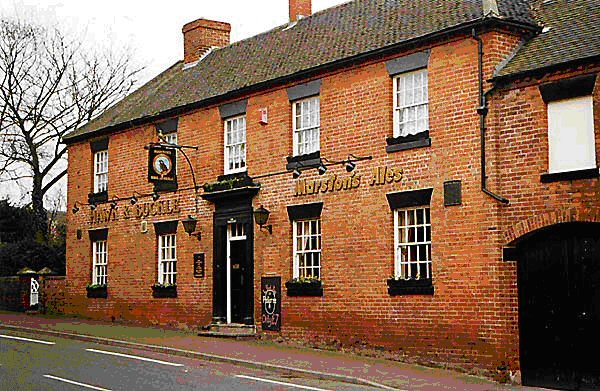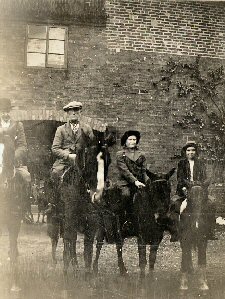|
THE HAWK AND BUCKLE
Derek Roome November 2008

The Hawk and Buckle is sited on the south-east side of Main Street, which was once part of the ancient route way from Derby westwards to Uttoxeter. This was made a turnpike in 1759 and so was the precursor to the A516 which ran through Etwall until the opening of the bypass in 1991. In 1804 it was recorded that a land auction took place at the Hawk and Buckle and this is the earliest reference we have for the name. However, since the licensed victuallers’ records show that Etwall had two inns from at least the sixteenth century, it seems reasonable to suggest that the Hawk was one of these and, with the Spread Eagle, has a long history of offering stabling and other facilities to weary travellers.
The archway to the right of the main building leads to what used to be the stable yard with accommodation for six horses. On one occasion an unusual occupant, an elephant, was stabled here by a visiting circus which is said to have performed on the cricket field!
|

|
When the Hawk was being redecorated and some of the old plaster removed from the outside walls, a brick was exposed which bore the mark ‘EC 1829’. It is not difficult to decipher this as a reference to the Cotton family and Elizabeth Cotton had succeeded to the manor in 1827. Could ‘EC’ have been her first son Edward or second son the Rev. Evelyn Cotton? The Rev. Cotton was owner in 1840 but his full name was Charles Evelyn Cotton so perhaps he only used his second given name?
|
|
The Cotton family sold the pub in 1890 to Thomsons, later to become Marstons, the Burton-upon-Trent Brewery.
|

|
The pub sign is that of a buckled hawk which features on the armorial crest of the Cotton family who were lords of the manor of Etwall and resident at Etwall Hall from the early eighteenth century. Indeed during the nineteenth century the Hawk was at times referred to as the‘Cotton Arms’.
|
|
A report in the Derby Mercury: shows something of the function of the Hawk in the local community. ‘In Etwall we must report an excursion by the Burton on Trent Natural History and Archaeological Society, forty of whose members enjoyed an excursion to Etwall in 1880. After a stroll around the village, they partook of an excellent tea at the Hawk and Buckle and then returned to Burton on the 6.45 train. Perhaps in the future longer journeys would be taken by the resourceful body of folk.’
There were stabling facilities at the Hawk and Buckle, an Inn dating back to at least 1804 (Arthur Smith - Portrait of a Derbyshire Village)
|

|
This picture was taken in the stable yard of the Hawk & Buckle in the early 1930’s. It shows Bob Toye (flat cap) who stabled his horses at the Hawk. Next to him on the pony is “Bunty” Tailby of Repton, later to become the owner of the Blue Bus Company. The ponies’ names were “Salt” & “Pepper”!
|
And we also know that meetings where held at the Hawk and Buckle to arrange celebrations for Queen Victoria’s Golden Jubilee, chaired by Major Rowland Hugh Cotton in 1887. (Arthur Smith - Portrait of a Derbyshire Village).
Hawk & Buckle Licensees
|
1828 – 29
|
PeggyCrosley
|
|
1829 – 35
|
William Slater
|
|
1840
|
William Taylor
|
|
1841
|
?Taylor
|
|
1857
|
Ann Taylor
|
|
1871
|
William Taylor
|
|
1881
|
Mary Taylor
|
|
1907 - 33
|
Stephen Ernest Laver
|
|
1933 – 40
|
Alan Thomas Clarke Fletcher
|
|
1940 – 43
|
James Grimes
|
|
1943
|
Harold Ball
|
|
We know most about the Lavers ,Adelaide Frances and her husband Stephen Ernest, tenants in the early twentieth century, whose family history has been researched. They settled in Etwall and managed The Hawk and Buckle for 26 years. Two daughters were born to them , Violet Audrey M. in 1907 and Lillian in 1913. Occasionally, the pub would run out of beer and the clients would club together and a barrel would be fetched by horse and cart from Marston's Brewery in Burton! It had to be paid for in cash since the credit had often run out. The Hawk, like the Spread Eagle, had a billiards room with a full size table and also, like the Spread, the local lads were not encouraged to use it by landlord Mr Ernest Laver, for he liked to keep it available to any better class of friends who dropped in for a game.
Adelaide's mother, Frances Jane Hubbard Harrison died at "The Hawk and Buckle" on the 7th February 1928, aged 73, and was buried with her husband Frank in Findern Churchyard. Adelaide Frances died only a few days afterwards, on the 28th of February 1928, when she was only in her early forties and is buried in Etwall Churchyard.
Audrey Laver’s Wedding Day. 30th April 1930 approaching the Church steps with her father Ernest Laver.
Second picture shows Bride and Groom Richard T Griffiths (Dick) returning to the Hawk & Buckle after the service.
Stephen Laver retired to Almshouse 8 in Etwall. On the night of Friday the 20th January 1967, a fire started in his home and it is thought that he fell asleep in his armchair whilst smoking a cigarette. The Fire Brigade attended and Stephen was found dead on the floor. The whole incident was recorded in The Derby Evening Telegraph on the following day.
Violet Audrey Laver, who was born in 1907 and lived with her parents at The Hawk and Buckle, married Richard Griffiths and emigrated to Manitoba, Canada in 1947. They had three children. She died in Canada 1991. Lillian Laver who, was born in 1913, also lived at The Hawk and Buckle. She married Geoffrey Melhuish Hakes and they lived in Derby. They had two sons. She survived her husband and died on 22nd of November 1990.
The Hawk continued to be a meeting place for local organisations including meetings of the British Legion, which were held in rotation at the Hawk and Buckle, Hilton’s Kings Head and the Every Arms at Eggington on the A38, 1955.
Finally, two nice stories!
Although the original Coaching Inn does not give the impression of great age, the cottage next door is rumoured to have given shelter to Oliver Cromwell. What is more, an underground passage is reputed to link the "Hawk" with the vicarage.
Historians tell us that "The Hawk & Buckle" was originally "The Cotton Arms" and how both -these names originated is an intriguing tale derived from the crest of the Port family which built and lived in Etwall Hall in the mid 16th century. When John Port the second was knighted at the coronation of Edward VI, the College of Heralds, with it's usual dry wit, formulated a crest appropriate to the name 'Port' via the French verb "portir or porter", meaning "to carry'", thereby saddling the family with a carrier pigeon which possibly bore or was supported by a 'fret'. A 'fret', to the peasant mind, can only suggest a buckle; after all, did not the country-man see buckles by the score upon belts and harness? "But why” you may ask, "should the country-man confuse a pigeon with a hawk?"
|